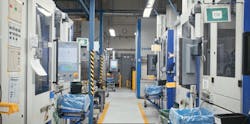2025 IndustryWeek Best Plants: Freudenberg-NOK Santa Ana Leads with Lean
Freudenberg NOK Santa Ana produces gaskets. The word belies its complexity: Gaskets, of which O-rings are but one type, are critical but easy-to-overlook components of many machines. They fit between two surfaces, often with the purpose of forming a seal, but they must also do so under radically different circumstances, with serious consequences for failure.
Without a functioning gasket, my Bialetti Moka pot would not brew coffee, and might explode — though it would be a relatively small issue compared to what happens in more energetic systems, like jet engines, do when gaskets fail. And some of Freudenberg NOK Santa Ana’s gaskets do end up in jet engines. Manufacturing gaskets requires controlling for chemistry, shape, temperature control, nonreactivity, and durability under often extreme circumstances.
With such stringent requirements, Freudenberg NOK Santa Ana must produce products of impeccable quality. But Freudenberg NOK Santa Ana’s gaskets and O-rings don’t just wind up in jet engines. They also end up in landing gear, hydraulic systems, aircraft fuel controls, power transmissions, gas pumps, construction and agriculture equipment, and even those unusual soda dispensers that dispense an elaborate mix of pop from a single nozzle.
In short, Freudenberg-NOK Santa Ana produces many products well, on a low-volume high-stakes basis. The difficulty of that model, and the quality standards that enable it, qualify Freudenberg-NOK Santa Ana as a member of the IndustryWeeks Best Plants class of 2025.
Freudenberg-NOK Sealing Technologies, Santa Ana
- Santa Ana, California
- Employees: 175
- Total Square Footage: 39,000
- Primary Products: O-rings and injection/compression molded gaskets
- Start-up Date: 1975, as International Seal Co. (purchased by Freudenberg-NOK in 1998)
- Achievements: 2025 IndustryWeek Best Plants Award Winner, 2022 and 2024 Raytheon/RTX Supplier Platinum Award, Best Lean Award, Six Sigma Award
Quality Products, Quality Processes
Eugen Amann, Application Center Manager at Freudenberg-NOK Santa Ana, tells IW that FNOK’s outstanding quality is its outstanding product knowledge.
“When big OEM customers come, they’ve obviously seen many other O-ring suppliers. And you would think of an O-ring as a simple, simple part,” he said. “But the amount of innovation and product know-how and manufacture know-how that we put in, it sets us apart, and that’s what we get recognized for.”
The various gaskets and O-rings aboard aircraft form a good example of the quality standards Freudenberg-NOK Santa Ana has to uphold. These gaskets have to withstand high-energy systems, temperature variance, and chemical interactions.
For example, Freudenberg gaskets in landing gear have to maintain an aircraft’s tire pressure under pressure sufficient to land a plane. It has to do this while withstanding temperature differentials between negative 45 degrees Fahrenheit and 158. And O-rings inside jet engines have to handle long-term continuous operating temperatures close to 400 Fahrenheit as well as chemical compatibility with jet engine turbine lubricants. Heat exchanger systems, which use heated air from the engine to de-ice the wings, have to handle high-pressure, high-temperature air from the engine as well as low-pressure, low-temperature air in the wings and cabin.
Freudenberg-NOK makes gaskets for all of these capacities, as well as O-rings for Boeing aircraft hydraulic systems, and more. The 39,000-square-foot plant of 175 employees produces O-rings and other shapes of gasket for about 250 customers out of 90 different compounds.
At the plant, uncured rubber is closely inspected before entering inventory, then prepared for molding. The plant makes the gaskets in compression or injection molds. Depending on the specific demands of the product, including size and material, the molded parts are sometimes trimmed by hand, or de-flashed cryogenically — flash-frozen, with excess parts cleanly snapped off after. Finished rings are inspected, packaged, and shipped.
Each step of the process is awash with visual cues, labels, and other poka-yoke error prevention methods. In the above process, raw material for gaskets is stored in blue bins; newly-formed gaskets would go in yellow boxes; scrap cut or de-flashed from them would go into red boxes, and finished gaskets would go into green bins.
While FNOK does have a wide variety of gaskets with interesting shapes, it’s also true that many gaskets are simple, round, black, rubber O-rings. This produces its own kind of quality control problem: When your parts are as small and indistinct as a black, 10-mm rubber O-ring, processes are necessary to keep them from being mixed up with black, 11-mm rubber O-ring. The solution was developed by an engineer at the plant: Add a to-scale watermark of each O-ring to the digital or paper order attached to it. If a gasket’s place in an order was in doubt, one can simply call up the work order on a horizontal screen and drop the ring onto it for a quick visual comparison.
Full-team lean
Instrumental for lean principles is respect for employees autonomy, and FNOK marked a striking version of employee autonomy in action.
While touring the site, I noticed labels indicating the proper placement of tools and machines everywhere. The plant floor, of course, but also the testing labs, the quality control area, the offices, and even the bathrooms and cafeteria had labels and tape to set out where things were meant to go. While on the floor, Amann showed me the label station, which workers were always free to access, and which was refilled whenever necessary. The ubiquity of the labels struck me as a unifying feature of the factory, so that wherever one worked, one would always know where things went.
Later, in the quality-control room, I noticed another example of continuous improvement at work: Knitting needles. Specifically, jars of them on the desks of the quality-control department. It turned out that knitting needles, which come in a variety of colors and materials as well as standardized sizes, were perfectly suited for precisely manipulating and closely examining rubber gaskets, an innovation discovered by one of the quality control employees there. It quickly caught on.
Floor worker autonomy isn’t limited to labels and knitting needles, either. FNOK employee work teams are enabled to work on production scheduling, skills certification, safety and environmental compliance, quality assurance, daily job assignments, performance reviews, training, hiring, and materials management. Vacation spending is done in work teams on a first-come, first-served basis, and team leads even weigh in on disciplinary actions and terminations.
And in exchange for its employees’ investment, FNOK invests in its employees. The plant offers gain-sharing rewards for individual performance, rewards for team performance, profit-sharing, and paid knowledge and skills training — including, of course, lean management system training.
According to Amann, this is consistent with the plant’s perspective on leadership. “Leadership, for us, doesn’t mean that just the management team is supposed to lead,” he said. "Leadership is also expected to come from all levels of the organization."
About the Author
Ryan Secard
Associate Editor
Ryan Secard joined Endeavor B2B in 2020 as a news editor for IndustryWeek. He currently contributes to IW, American Machinist, Foundry Management & Technology, and Plant Services on breaking manufacturing news, new products, plant openings and closures, and labor issues in manufacturing.



